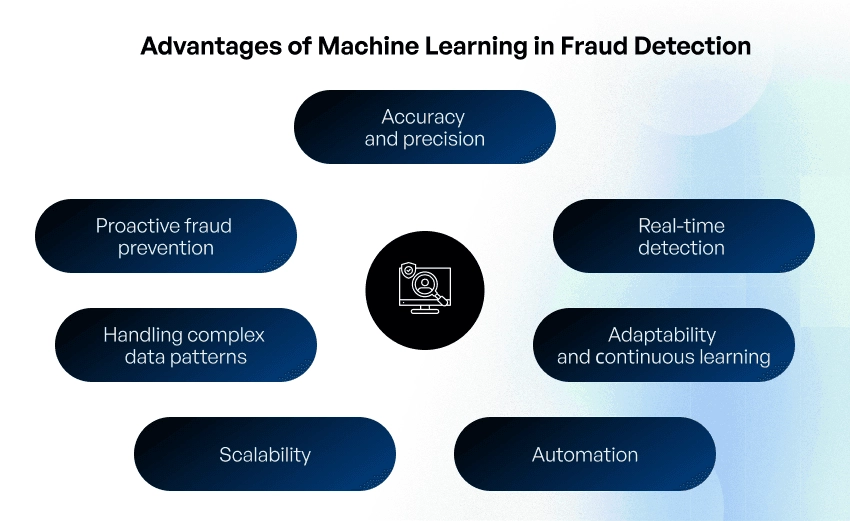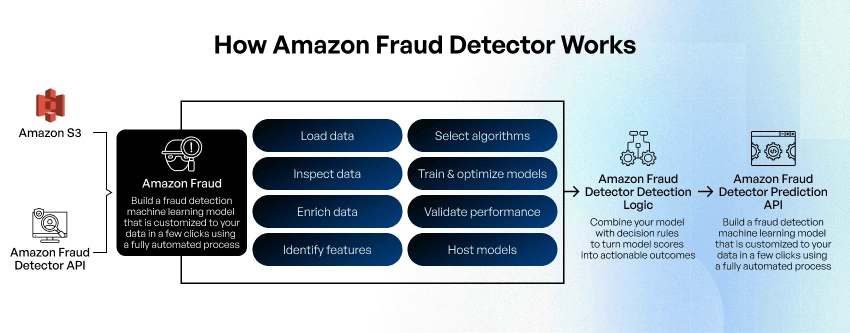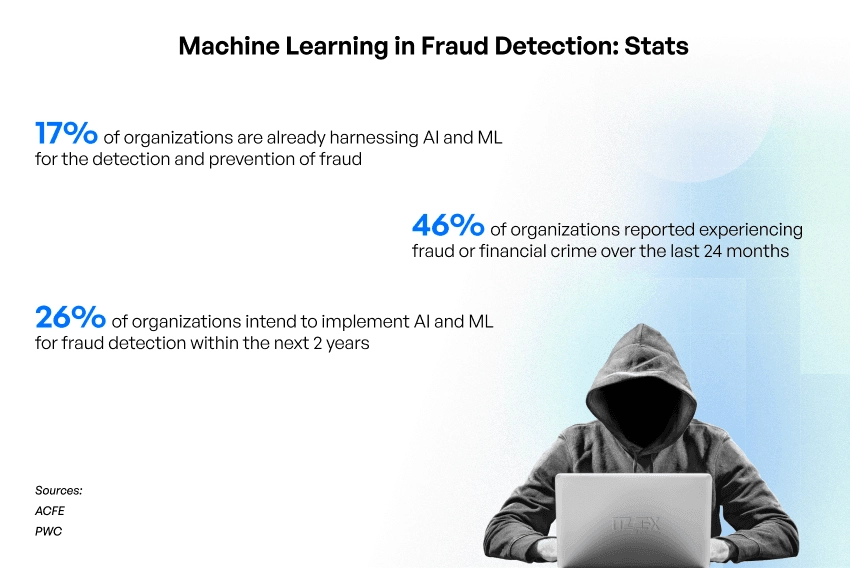How to Use Machine Learning in Fraud Detection: Real-Life Examples and Emerging Trends

Fraud is a formidable challenge that can result in substantial financial losses and reputational damage. Its occurrence spans industries such as finance, insurance, e-commerce, healthcare, and more, emphasizing the crucial need for robust fraud detection mechanisms.
In the face of evolving and sophisticated fraudulent activities, traditional rule-based methods are often insufficient to detect intricate patterns or anticipate emerging fraud strategies.
Machine Learning is a robust tool in the fight against fraud. By harnessing the power of data analysis and pattern recognition, ML algorithms can learn from historical data to detect subtle anomalies and deviations from normal behavior.
In this article, we will draw insights from experts at Alternative Spaces to shed light on the potential and practicality of ML-driven fraud detection methodologies. We demonstrate how Machine Learning, underpinned by advanced algorithms and data analysis, can revolutionize fraud detection, leading to a more secure and resilient business landscape.
Table of contents
- Limitations of Traditional Fraud Detection
- Advantages of Machine Learning in Fraud Detection
- Use Cases of Machine Learning for Fraud Detection
- Real-World Examples: How They Use Machine Learning in Fraud Detection
- Emerging Trends in Machine Learning for Fraud Detection
- Conclusion
- FAQ
Limitations of Traditional Fraud Detection
Traditional fraud detection methods, though widely used, come with several inherent limitations that can hinder their effectiveness in today’s dynamic and complex fraud landscape. These limitations include:
Rigidity and inflexibility
Traditional fraud detection systems are based on predefined rules. They can effectively detect known fraud patterns but struggle to adapt to new, emerging threats. As fraudsters continuously refine their strategies, rule-based systems can quickly be updated.
False positives
Rule-based systems may generate a high number of false positives. These false alarms can overwhelm investigators with non-fraudulent cases, leading to inefficient use of resources and potentially missed genuine fraud cases.
Lack of contextual understanding
Traditional systems often lack the ability to analyze the context of a transaction or behavior. They may flag legitimate transactions as suspicious simply because they deviate from predefined rules without considering factors that might explain the deviation.
Inability to detect complex patterns
Rule-based approaches are limited in detecting intricate, complex fraud patterns. They may excel in spotting simple, rule-based fraud but struggle when faced with multifaceted, adaptive fraud schemes.
Human bias and error
Traditional systems are inherently influenced by the biases and errors of their human designers. If the rules do not account for all potential scenarios or are influenced by unconscious biases, the system’s accuracy can be compromised.
Difficulty in handling big data
Traditional systems may struggle to efficiently process and analyze the vast amounts of data generated in modern transactions, making them less suitable for today’s data-intensive environments.

The limitations of traditional fraud detection underscore the need for more advanced techniques. Machine Learning in fraud detection, with its ability to learn from data, adapt to new trends, and consider complex patterns, offers a promising solution to address these shortcomings.
Advantages of Machine Learning in Fraud Detection
Machine Learning has emerged as a powerful tool in fraud detection, offering various advantages that significantly enhance an organization’s ability to combat fraudulent activities. Below, we delve into the key benefits of using machine learning for fraud detection:

Accuracy and precision
ML models are exceptionally effective at discerning intricate patterns within data. They can differentiate between legitimate and fraudulent transactions with high accuracy, significantly reducing false positives. This precision is critical in preventing unnecessary disruptions for genuine customers and focusing investigative efforts where they are truly needed.
Real-time detection
Fraud can occur swiftly, and its consequences can be severe. ML-powered fraud detection systems can operate in real time, analyzing transactions, behaviors, or activities as they happen. This immediate response allows organizations to halt fraudulent activities and minimize potential losses.
Read also: How Artificial Intelligence (AI) Will Transform Your Business
Adaptability and сontinuous learning
Fraudsters are perpetually evolving, creating new tactics and adapting to countermeasures. ML models excel in adaptability. They learn from historical data and adjust their detection strategies accordingly. This means they can rapidly identify emerging fraud patterns and adjust without requiring manual rule changes, keeping organizations one step ahead of fraudsters.
Automation
ML automates the fraud detection process. It can handle large volumes of data without human intervention, reducing the need for extensive manual work. This saves time and resources and enables organizations to focus on more complex investigative tasks that require human expertise.
Scalability
ML models are scalable and can process vast amounts of data. This is particularly advantageous in industries with high transaction volumes, like finance, e-commerce, or healthcare. ML can maintain its effectiveness in detecting fraudulent activities regardless of the data size.
Handling complex data patterns
Fraud can manifest in diverse and complex patterns that are challenging for traditional rule-based systems to detect. ML models can consider multiple data points simultaneously, recognizing complex relationships and non-linear patterns that might elude human-designed rules.
Proactive fraud prevention
ML models detect fraud after the fact and identify potential fraud risks before they escalate. These models can uncover hidden trends and vulnerabilities by analyzing historical and real-time data, enabling organizations to take preventive measures.
The advantages of using machine learning to detect fraud are numerous and significant. From accuracy and real-time detection to adaptability, automation, scalability, and the ability to handle complex data patterns, ML empowers organizations to combat fraud effectively and efficiently.
Use Cases of Machine Learning for Fraud Detection
Machine Learning has found various applications in fraud detection across multiple industries. Here are some prominent use cases of fraud detection with machine learning:
Credit card fraud detection
Credit card fraud detection is one of the most common applications of machine learning. ML models analyze transaction data, such as purchase history, transaction amounts, and locations, to detect unusual patterns that may indicate fraudulent activity. The system can trigger alerts or request further verification when a transaction deviates from the cardholder’s typical behavior.
Advantages:
- Protects cardholders from unauthorized transactions.
- Minimizes financial losses for both cardholders and banks.
- Enhances trust in the use of credit cards for online and offline transactions.
Healthcare fraud detection
In the healthcare industry, ML helps detect fraudulent insurance claims, billing irregularities, and overutilization of medical services. ML models can flag suspicious billing practices and potentially fraudulent claims by analyzing vast datasets of medical claims and patient information.
Advantages:
- Reduces healthcare costs and insurance premiums.
- Ensures fair billing practices.
- Preserves the integrity of healthcare systems.
Ecommerce fraud prevention
Ecommerce businesses utilize ML to identify various types of online fraud, including payment fraud, account takeover, and fake reviews. ML models analyze transaction data, user behavior, and website interactions to detect suspicious activity and prevent unauthorized transactions.
Advantages:
- Safeguards online shoppers from fraudulent activities.
- Minimizes financial losses for e-commerce companies.
- Maintains a secure and trustworthy online shopping environment.
Insurance claims fraud detection
Insurance companies use ML to scrutinize claims for signs of fraud. ML models analyze claim data, historical records, and other relevant information to identify potential cases of fraudulent claims. This helps insurance providers reduce losses and maintain fair premiums.
Advantages:
- Reduces insurance fraud and financial losses.
- Keeps insurance premiums reasonable for policyholders.
- Improves the overall integrity of insurance processes.
Banking and payment fraud prevention
In the banking and financial sector, ML is employed to monitor transactions in real time. ML models can detect unusual account activities, unauthorized fund transfers, and potential identity theft cases. These models help banks protect customers and maintain the security of financial systems.
Advantages:
- Protects customers from financial losses.
- Enhances the security of financial transactions.
- Mitigates risks related to identity theft and unauthorized account access.
Read also: AI-Powered Banking: Transformative Trends, Insights and Use Cases
These use cases demonstrate the versatility of ML in addressing various fraudulent activities across different industries, helping organizations protect their assets, maintain trust, and reduce financial losses.
Real-World Examples: How They Use Machine Learning in Fraud Detection
Visa prevents $25 Billion in fraud using Artificial Intelligence
Visa’s fraud detection system uses ML algorithms to analyze transaction data in real-time. When a transaction occurs, the system assesses various factors, such as transaction amount, location, and cardholder behavior. If the transaction deviates from the cardholder’s usual spending patterns or exhibits suspicious behavior, it triggers an alert or requests additional authentication.
This proactive approach has significantly reduced instances of credit card fraud. Utilizing artificial intelligence has enabled financial institutions to thwart approximately $25 billion in annual fraud, thereby enhancing the global payment ecosystem’s security for retailers and consumers.
Amazon: Utilizing AWS customers’ datasets to train models
Amazon offers a fully managed service called Amazon Fraud Detector, which leverages machine learning technology and the company’s two decades of expertise in combating online fraud.
To utilize this service, AWS customers must integrate with it through an API and provide historical data, including indicators for both fraudulent and legitimate transactions. Amazon then combines this customer-provided data with its own to build models that can detect potential instances of identity theft or suspicious transactions.

How Amazon Fraud Detector Works
Source: AWS
JPMorgan Chase: Taking proactive measures to thwart threats
Bank JPMorgan Chase employs machine learning to continuously oversee online transactions, reaching an annual payment volume of $1.1 trillion. Thanks to these advanced technologies, the bank has achieved a 50 percent reduction in credit card fraud losses over the past five years.
Their ML models continuously monitor transactions and analyze various factors, including transaction amount, location, and user behavior. Any unusual or suspicious activity triggers alerts or additional security measures.
PayPal protects billions of transactions using ML
PayPal, a payment processor and gateway provider with over 200 million active accounts worldwide, allocates an annual investment of $300 million towards anti-fraud technologies. A decade ago, their system primarily relied on logistic regressions, a widely used supervised learning algorithm for classification. Subsequently, they introduced more sophisticated supervised learning techniques, including Gradient Boosted Trees (GBTs) and neural networks. This enhancement resulted in a remarkable 50 percent improvement in the system’s accuracy.
At present, PayPal has adopted a novel approach by harnessing the power of deep learning, leveraging extensive fraud data accumulated over the years. Deep learning models have already demonstrated a 10 to 20 percent boost in accuracy compared to traditional machine learning algorithms for real-time fraud detection. As a testament to their efforts, PayPal’s latest reported fraud loss rate stands at 0.28 percent, equivalent to 28 cents for every $100 processed.
These real-world examples showcase the successful application of machine learning in fraud detection across a variety of industries. By leveraging ML’s ability to analyze data, detect anomalies, and respond to potential fraudulent activities, organizations can protect their assets, maintain trust, and reduce financial losses.
Emerging Trends in Machine Learning for Fraud Detection
The field of machine learning in fraud detection continues to evolve rapidly, driven by advancements in technology and the dynamic nature of fraudulent activities.

Below are the potential advancements and emerging trends of machine learning for fraud detection:
Deep learning and neural networks
Deep learning and neural networks are an emerging trend in fraud detection, revolutionizing the field by excelling at recognizing complex fraud patterns. They offer real-time detection, reduce the need for manual feature engineering, adapt to evolving threats, and handle various data types.
Let’s delve into why deep learning and neural networks are considered a significant trend in this field:
- Complex pattern recognition. Deep learning excels in recognizing intricate patterns, adapting to evolving fraud tactics in real-time.
- Real-time detection. Deep learning enables real-time data analysis, which is crucial in finance and ecommerce for preventing significant losses with quick, automated security decisions.
- Reduced reliance on manual feature engineering. Deep learning reduces manual work, autonomously extracting relevant data relationships, streamlining development, and enhancing adaptive responses to evolving fraud patterns.
- Versatility with data types. Deep learning’s versatility spans diverse data types in fraud detection, enabling insights from structured and unstructured data for adaptability across various scenarios.
- Adaptive learning. Adaptive deep learning evolves with changing fraud patterns, adjusting parameters, and learning from new data for ongoing accuracy in detection.
Explainable AI (XAI)
Explainable AI (XAI) is an emerging and vital trend in fraud detection. XAI focuses on making machine learning models more transparent and interpretable, enabling organizations to understand the decisions made by these models. Here’s a closer look at why XAI is gaining prominence in fraud detection:
- Enhanced transparency. XAI offers transparent, understandable explanations for machine learning predictions, which is critical in regulated industries emphasizing accountability.
- Improved trustworthiness. XAI builds trust in fraud detection by making machine learning decisions transparent and understandable for investigators and compliance officers.
- Regulatory compliance. XAI aids compliance in regulated sectors like finance and healthcare by providing interpretable models for more accessible scrutiny and validation.
- Root cause analysis. In fraud detection, XAI helps pinpoint root causes, enabling effective fraud prevention strategies.
- Model debugging. XAI aids in debugging and enhancing machine learning models by revealing decision insights facilitating issue identification and resolution in fraud detection.
Graph-based analytics
Graph-based analytics is an increasingly prominent trend in fraud detection, leveraging graph theory and network analysis to uncover complex patterns and relationships in data. Here’s an exploration of why graph-based analytics is gaining traction in the context of fraud detection:
- Network insights. Graph-based analytics uncovers intricate connections between entities, like customers and transactions, identifying hidden links not obvious through traditional methods.
- Anomaly detection. It identifies irregular behavior and connections that may signify fraudulent activities.
- Real-time analysis. Graph-based analytics operates in real-time, facilitating swift responses to emerging threats and potential fraud.
- Holistic view. It provides a holistic view, uncovering fraud rings and collaborative schemes involving multiple entities working together to commit fraud.
- Scalability. This approach is highly scalable and can accommodate large volumes of data, making it suitable for industries with high transaction volumes, such as finance and e-commerce.
Read also: Everything you need to know about anomaly detection in ML
Behavioral biometrics
Behavioral biometrics involves analyzing and recognizing unique patterns in human behavior, such as keystroke dynamics, mouse movements, voice intonations, and even how users interact with touchscreens and devices. This trend is gaining prominence for several reasons:
- Inherent user characteristics. Behavioral biometrics use unique user attributes, like typing speed and device interaction, making impersonation by fraudsters challenging.
- Continuous authentication. Behavioral biometrics provide continuous authentication, monitoring user behavior throughout a session for ongoing security, in contrast to static methods like passwords or PINs.
- Low intrusiveness. Behavioral biometrics run in the background without user involvement, enhancing security and user experience.
- Adaptive security. Behavioral biometrics adapt to changing user behavior, preventing legitimate users from being locked out due to genuine changes.
- Multi-modal approach. Combining behavioral biometrics like keystroke dynamics, mouse movements, and touchscreen interactions creates a robust multi-modal authentication approach.
These advancements and emerging trends reflect the dynamic nature of the field, with a focus on enhancing the accuracy, speed, and transparency of machine learning in fraud detection. Addressing these trends and staying at the forefront of technology will be vital for organizations aiming to combat fraud in an ever-evolving landscape effectively.
Conclusion
The diverse ways machine learning can be applied in fraud detection, from supervised learning for known patterns to unsupervised methods for uncovering novel anomalies, offer a comprehensive approach to identifying and mitigating fraudulent activities. Moreover, the advantages of automation, adaptability, and real-time detection change the game in the battle against fraud, enabling businesses to stay one step ahead of potential threats.
In this dynamic environment, organizations that stay at the forefront of technology and leverage machine learning in their fraud detection strategies will protect their bottom line and reinforce trust and security for their customers.
Don’t miss out on the future of security! Contact us, and our experts will help safeguard your business and customer trust.
FAQ
- How can businesses get started with implementing machine learning for fraud detection?
To get started, businesses should understand the basics of machine learning, assemble a skilled team, collect and prepare relevant data, choose suitable machine learning models, and integrate them into their real-time systems. Ongoing monitoring, compliance with regulations, and employee/customer education are also essential steps.
If you need help, feel free to contact us.
- Is machine learning for fraud detection suitable for small businesses?
Yes, machine learning can be beneficial for businesses of all sizes. Small businesses can leverage third-party solutions or cloud-based services to incorporate machine learning in their fraud detection efforts, making it accessible and cost-effective.
- Can machine learning models adapt to changing fraud tactics?
Yes, machine learning models can adapt to changing fraud tactics. Continuous monitoring, retraining, and the incorporation of new data and features allow the models to stay updated and effective in detecting evolving fraud patterns.
- What is the best machine learning algorithm for fraud detection?
The “best” algorithm depends on your specific use case, data quality, and available resources. It’s often recommended to start with a simple model like logistic regression or decision trees and then gradually experiment with more complex algorithms to see which one performs best for your particular fraud detection task. Additionally, ensemble methods and model stacking can also be effective in improving the overall accuracy of the fraud detection system. Regular monitoring and model retraining are essential to keep the system effective in the face of evolving fraud tactics.
Content created by our partner, Onix-systems.
Source: https://onix-systems.com/blog/machine-learning-in-fraud-detection Home
Home


